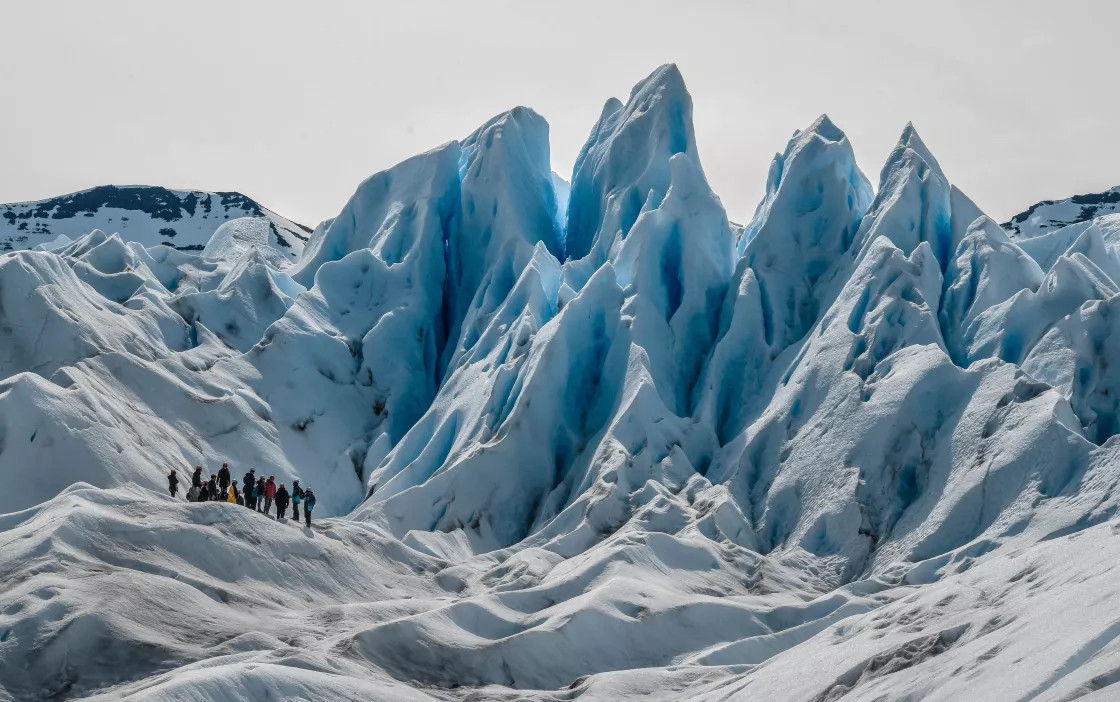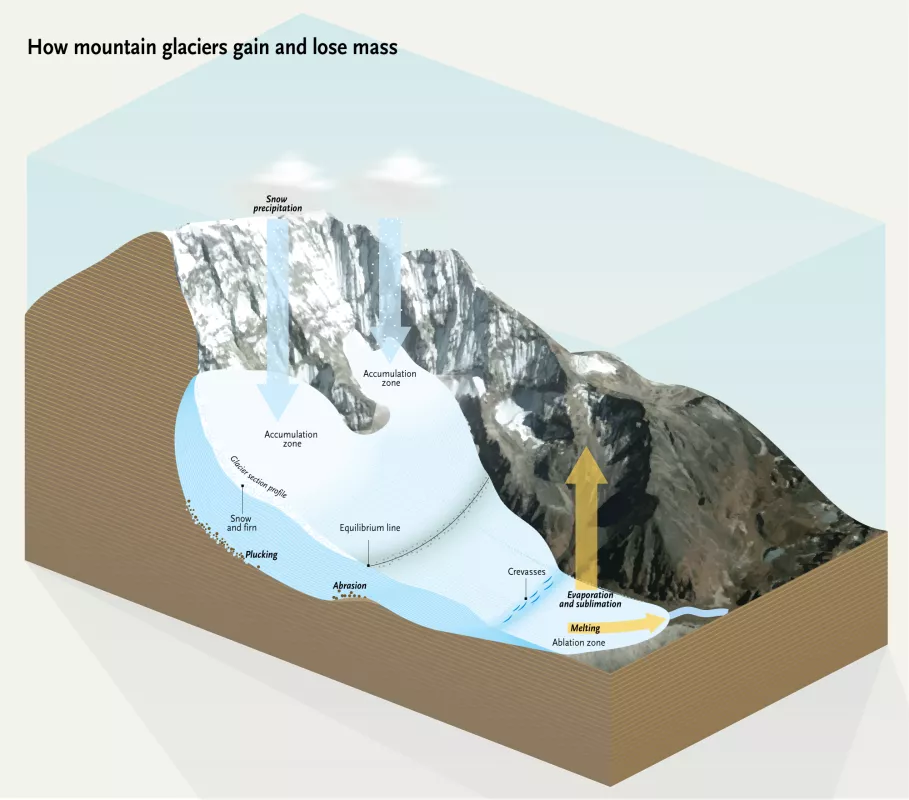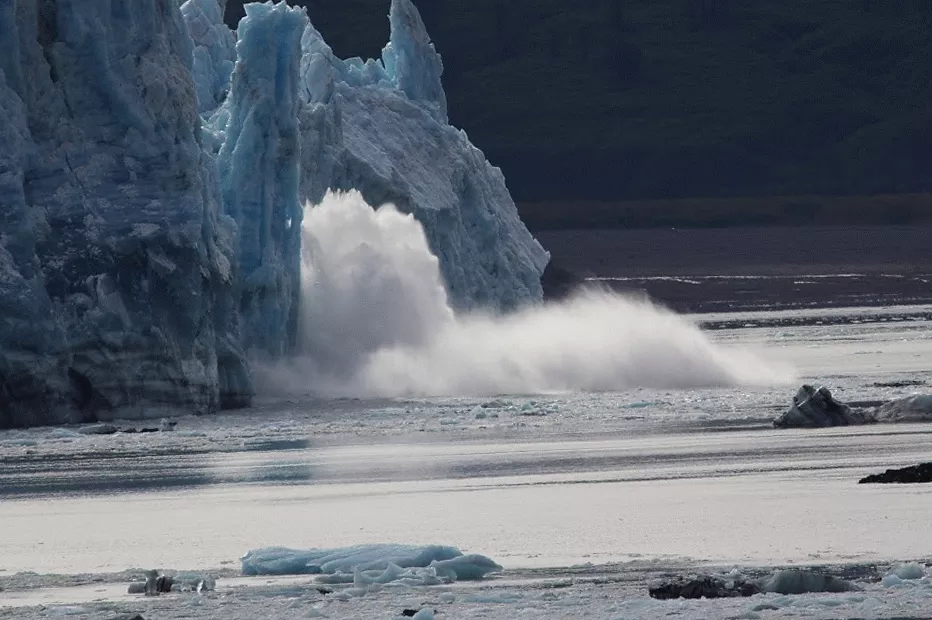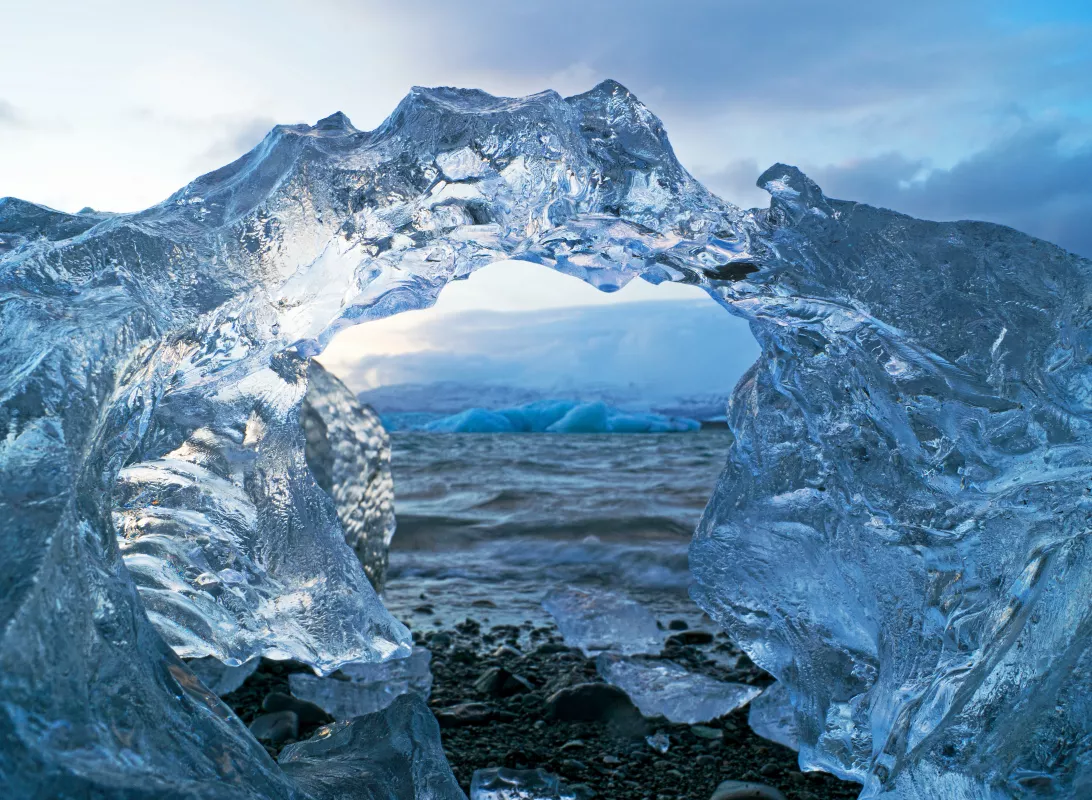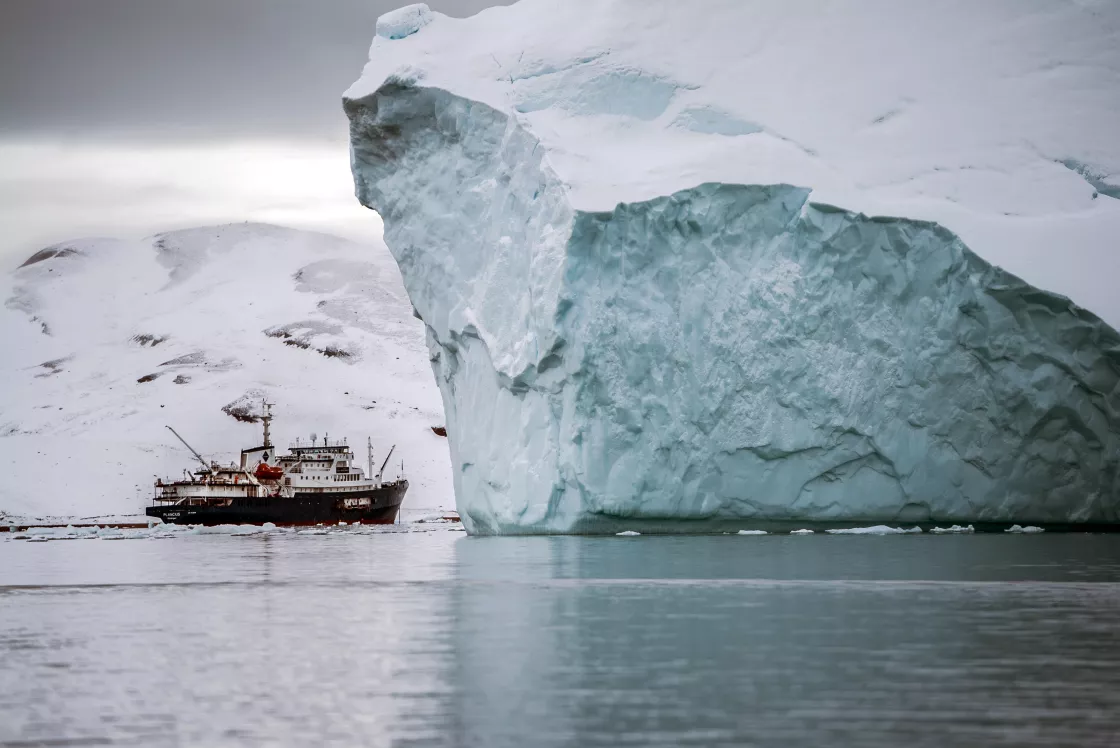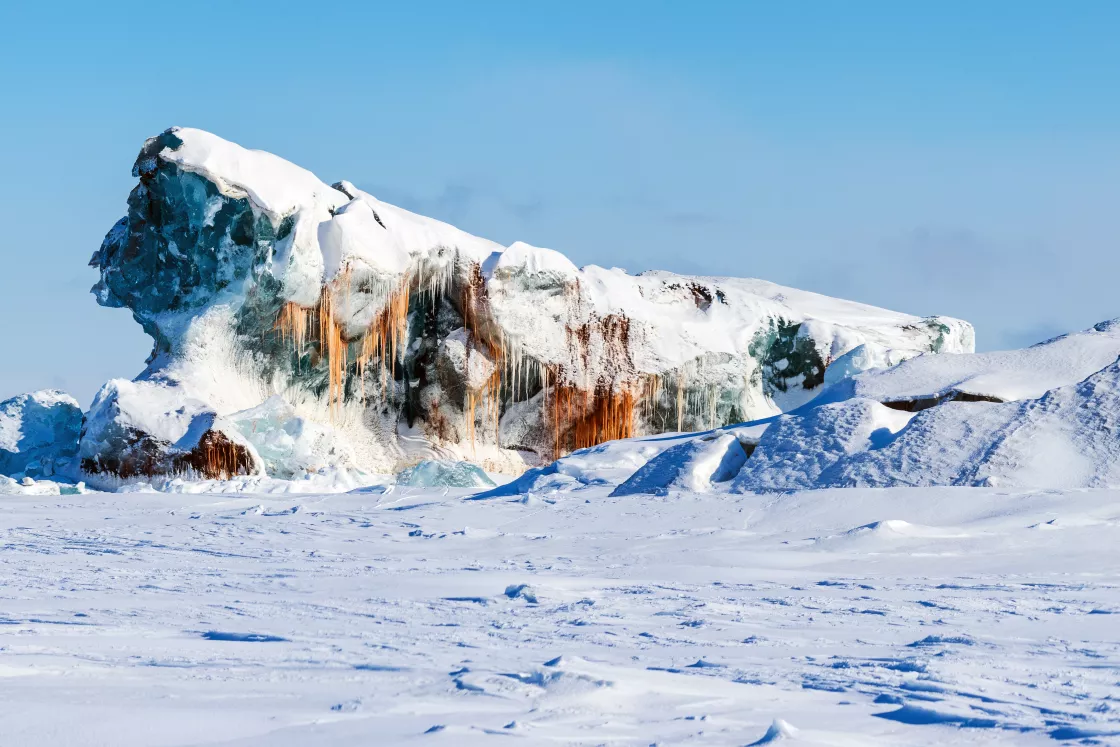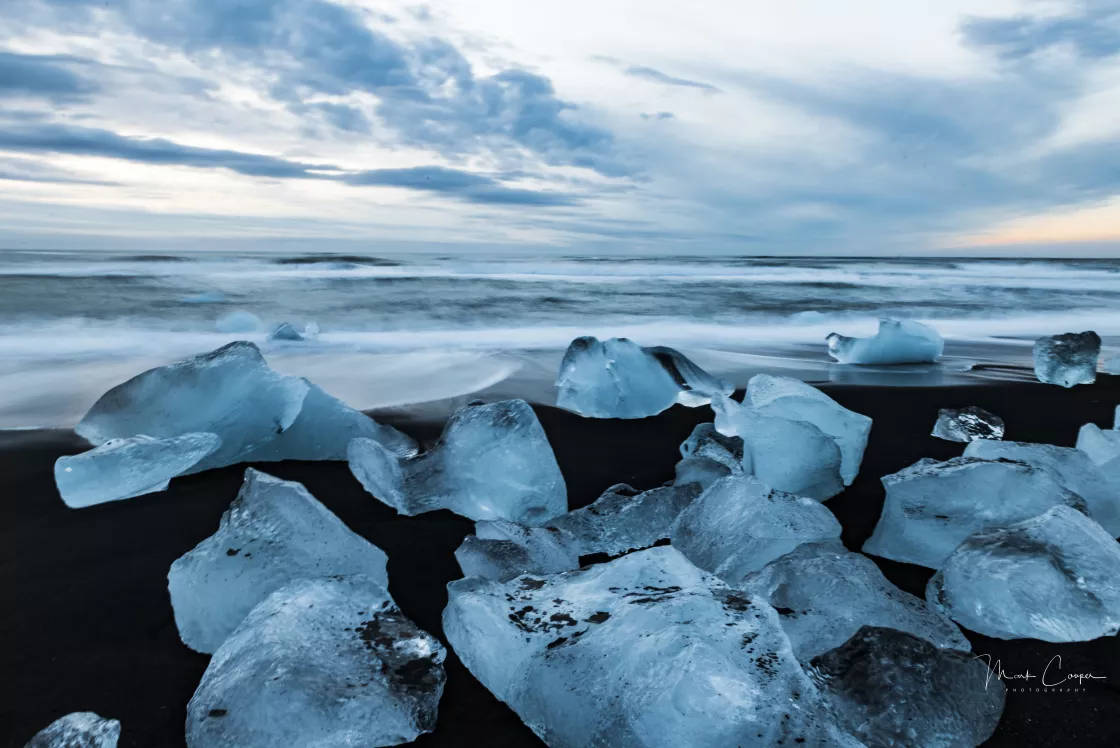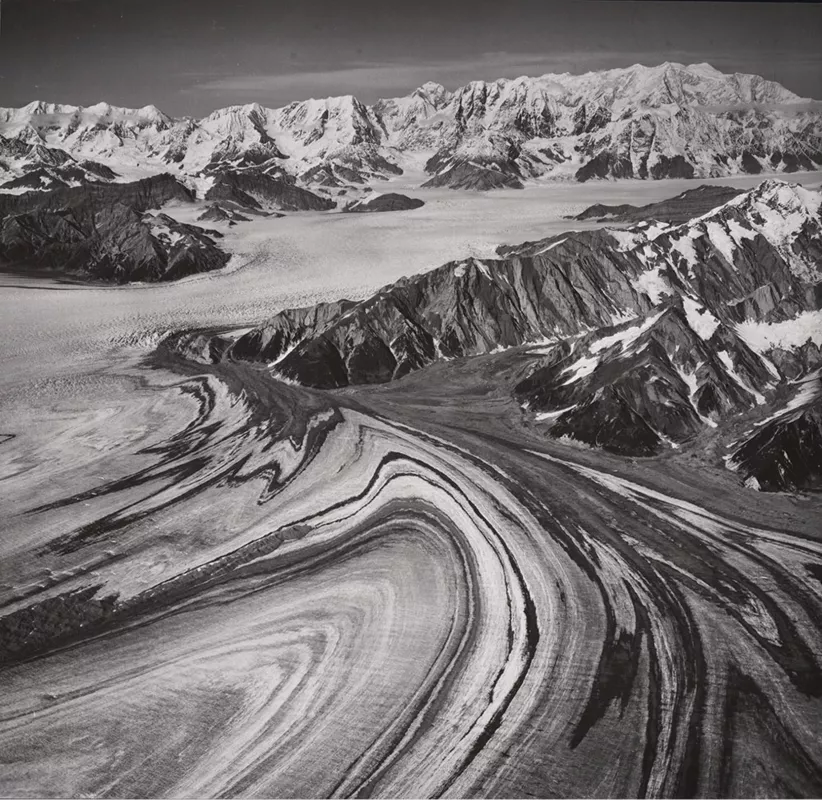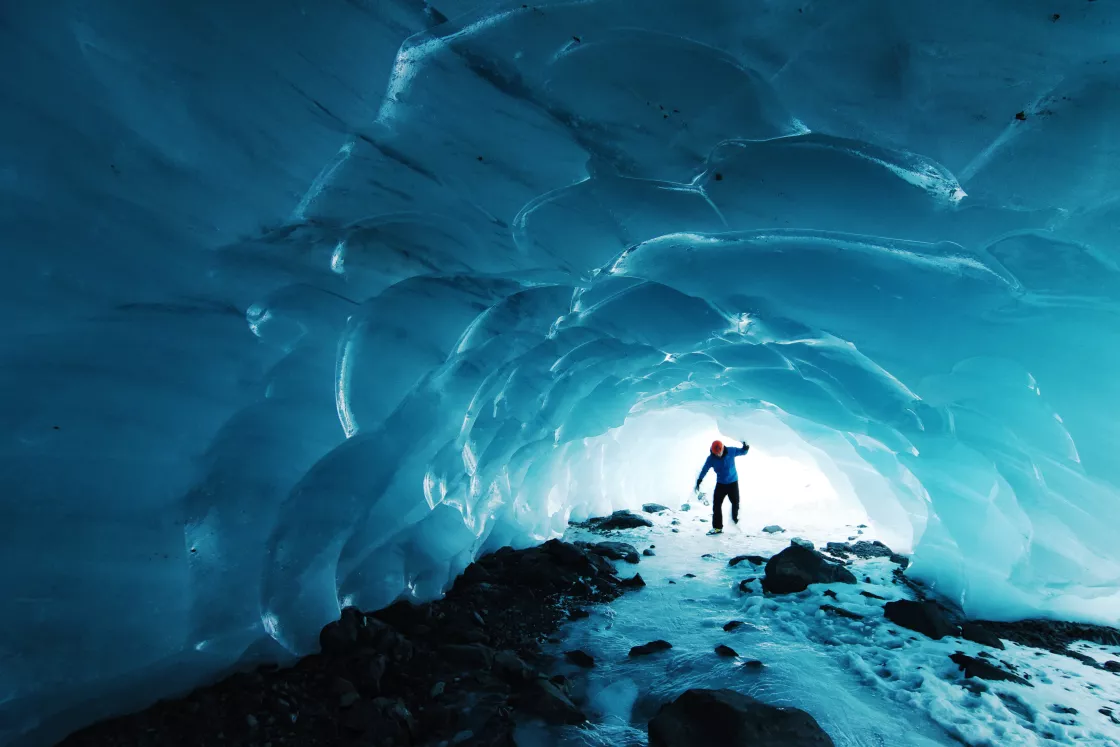Glaciers
Quick Facts
What is a glacier?
A glacier is an accumulation of ice and snow that slowly flows over land. Alpine glaciers are frozen rivers of ice, slowly flowing under their own weight down mountainsides and into valleys. Ice sheets exist only on Greenland and Antarctica, and they spread out in broad domes in multiple directions.
How does a glacier form?
Glaciers begin to form when snow remains and accumulates long enough to transform into ice. Each year, new layers of snow bury and compress the previous layers. This compression forces the snow to re-crystallize, initially forming grains similar in size and shape to grains of sugar.
Gradually, the grains grow larger and the air pockets between the grains get smaller, causing the snow to slowly compact and increase in density. After about a year, the snow turns into firn—an intermediate state between snow and glacier ice. At this point, it is about two-thirds as dense as water. Over time, larger ice crystals become so compressed that any air pockets between them are tiny. In very old glacier ice, crystals can reach the size of an adult fist. For most glaciers, this process takes more than a hundred years.
Is an ice sheet different from a glacier?
An ice sheet is a mass of glacial land ice extending more than 50,000 square kilometers (19,300 square miles). There are only two ice sheets on Earth today: the Greenland Ice Sheet and the Antarctic Ice Sheet. During the last ice age, ice sheets also covered much of North America and Scandinavia.
Together, the Antarctic and Greenland Ice Sheets contain more than 70 percent of the freshwater ice on Earth. The Antarctic Ice Sheet extends almost 14 million square kilometers (5.4 million square miles), roughly the area of the contiguous United States and Mexico combined. The Antarctic Ice Sheet contains 30 million cubic kilometers (7.2 million cubic miles) of ice. The Greenland Ice Sheet extends about 1.7 million square kilometers (656,000 square miles), covering most of the island of Greenland, and is about three times the size of Texas.
What are ice caps and icefields?
An ice cap is a type of glacier, covering less than 50,000 square kilometers (20,000 square miles). Like ice sheets, ice caps tend to spread out in dome-like shapes as opposed to flowing down slopes. Ice caps form in high-latitude polar and subpolar mountain regions. Northern Europe is home to many ice caps; for example, the Vatnajökull ice cap in Iceland and the Austfonna ice cap in the Svalbard archipelago of Norway, which is the largest (in area) in Scandinavia. The largest ice cap in the world is the Severny Island ice cap, part of the Novaya Zemlya archipelago in the Russian Arctic.
An icefield is a a mass of glacier ice, somewhat similar to an ice cap, but usually smaller and lacking a dome-like shape. compared to an ice cap, an icefield is more strongly influenced by underlying terrain.
What is an iceberg?
Icebergs are large floating chunks of ice, detached from a glacier, such as an alpine glacier or ice sheet, and carried out to the ocean. The word iceberg literally means ice mountain, berg borrowed from German.
Icebergs come in all shapes and sizes, from ice-cube-sized chunks to ice islands the size of a small country. The term “iceberg” refers to chunks of ice larger than 5 meters (16 feet) across. Smaller icebergs, known as bergy bits and growlers, can be especially dangerous for ships because they are harder to spot. The North Atlantic and the cold waters surrounding Antarctica are home to most of the icebergs on Earth. Antarctic ice shelves may calve icebergs that are over 80 kilometers (50 miles) long.
How do icebergs form, and where do they go?
Icebergs form when chunks of ice calve, or break off, from glaciers, ice shelves, or a larger iceberg. Icebergs travel with ocean currents, sometimes smashing up against the shore or getting caught in shallow waters.
When an iceberg reaches warm waters, the new climate attacks it from all sides. On the iceberg surface, warm air melts snow and ice into pools called melt ponds that can trickle through the iceberg and widen cracks. At the same time, warm water laps at the iceberg edges, melting the ice and causing chunks of ice to break off. On the underside, warmer waters melt the iceberg from the bottom up.
Why are icebergs important?
Icebergs pose a danger to ships traversing the North Atlantic and the waters around Antarctica. After the Titanic sank near Newfoundland in 1912, the United States and twelve other countries formed the International Ice Patrol to warn ships of icebergs in the North Atlantic.
The International Ice Patrol uses airplanes and radars to track icebergs that float into major shipping lanes. The U.S. National Ice Center uses satellite data to monitor icebergs near Antarctica. However, it only tracks icebergs larger than 500 square meters (5,400 square feet).
Icebergs can also serve as tools for scientists, who study them to learn more about climate and ocean processes.
Why do scientists study icebergs?
Climate scientists study icebergs as they break up for clues to the processes that cause ice shelf collapse. Scientists have noticed that the way icebergs break up when they reach warmer waters mirrors the disintegration of Antarctic ice shelves. By studying the factors that cause icebergs to break up, researchers hope to better understand the influences that lead to ice shelf breakup, and to better predict how ice shelves will respond to a warming climate.
Oceanographers follow icebergs because the cold fresh water they contribute to the sea can influence currents and ocean circulation far away from their origins.
Biologists study icebergs to find out how they influence ocean life. As icebergs melt, they leak nutrients into the surrounding ocean. Recent studies have shown that the water surrounding icebergs teems with plankton, fish, and other sea life.
How much glacial ice is on Earth?
Presently, 10 percent of land area on Earth is covered with glacial ice, including glaciers, ice caps, and the ice sheets of Greenland and Antarctica. Glacierized areas cover over 15 million square kilometers (5.8 million square miles).
During the maximum point of the last ice age, which ended about 12,000 years ago, glaciers covered about 32 percent of the total land area. The Antarctic continent has been at least partially covered by an ice sheet for the past 40 million years.
Starting around the early fourteenth century, and lasting to the mid-nineteenth century, the world experienced a “Little Ice Age,” when temperatures were consistently cool enough for glaciers to advance in many areas of the world.
In the United States, glaciers currently cover over 90,000 square kilometers (35,000 square miles). Most of those glaciers are located in Alaska, which holds 87,000 square kilometers (34,000 square miles) of glacial ice.
How big can glacial ice get?
The largest glacier, by area, is the Seller Glacier on the Antarctic Peninsula, measuring over 7,000 square kilometers (2,700 square miles). The largest ice crystals that make up a glacier can be as large as apples. However, there are many other ice masses on Earth that are much larger than the largest glacier. For example, glacier complexes such as icefields and ice caps can get as big as 80,000 square kilometers (31,000 square miles). Ice sheets such as the ones on Greenland and Antarctica are larger still. Greenland is 1.7 million square kilometers (656,400 square miles), and Antarctica is 1.23 million square kilometers (475,000 square miles). There are over 200,000 glaciers distinct from the ice sheets; and if all of these glaciers were to melt, they would increase sea level by just under half a meter (1.6 feet). If the entire Antarctic Ice Sheet melted, sea level would rise about 60 meters (197 feet). If the entire Greenland Ice Sheet melted, sea level would rise about 7.4 meters (24.3 feet).
The Lambert–Amery glacial system is the largest drainage system in East Antarctica with an area greater than 1,550,000 square kilometers (600,000 square miles), which is approximately 16 percent of the total area of East Antarctica. Antarctic ice is up to 4.9 kilometers (3 miles) thick in some areas. The land underneath parts of the West Antarctic Ice Sheet may be up to 2.5 kilometers (1.6 miles) below sea level.
The Kutiah Glacier in Pakistan holds the record for the fastest glacial surge. In 1953, it raced more than 12 kilometers (7.5 miles) in three months, averaging about 112 meters (367 feet) per day.
Which glaciers are the largest on Earth?
Different measurements can determine the world's largest glaciers such its length, area, volume, or mass. Length and area are easily obtained from satellite imagery. Volume and mass are more difficult because thickness and density (for mass) cannot currently be calculated from satellites.
The world’s largest glaciers by area are found in Antarctica, where large amounts of ice have accumulated—over long time periods—in spite of low annual precipitation because of the continent's low temperatures and relatively flat topography. The largest glacier in the world is Seller Glacier with an area of 7,018 square kilometers (2,710 square miles) located on the Antarctic Peninsula. This is slightly larger than the state of Delaware or slightly smaller than the Greek island of Crete. Thurston Island Glacier No. 1 is the second largest with an area of 5,261 square kilometers (2,031 square miles) and the third largest is Alexander Island Glacier No. 1 with an area of 4,766 square kilometers (1,840 square miles); both are located on Antarctic islands.
Outside Antarctica, the largest glaciers are Malaspina-Seward Glacier in Alaska with an area of 3,363 square kilometers (1,298 square miles), followed by Wykeham Glacier South in the Canadian Arctic with an area of 3,176 square kilometers (1,226 square miles), and then Bering Glacier in Alaska with an area of 3,025 square kilometers (1,168 square miles). Although Bering Glacier is the eighth largest glacier in the world by area, it is the longest in the world measuring 196 kilometers (122 miles) long.
How much water does glacial ice hold?
Glaciers and ice caps store about 68.7 percent of the world's fresh water, according to the US Geological Survey. If all land ice melted, sea level would rise approximately 70 meters (230 feet) worldwide.
Together, the Antarctic and Greenland Ice Sheets contain over 99 percent of the freshwater ice on Earth. The amount of fresh water stored in both the Antarctic and Greenland Ice Sheets totals over 68 percent of all the fresh water on Earth.
There are over 200,000 glaciers distinct from the ice sheets; and if all of these glaciers were to melt, they would increase sea level by just under half a meter (1.6 feet). If the Greenland Ice Sheet were to melt, it would increase sea level by approximately 7.4 meters (24.3 feet); and if the Antarctic Ice Sheet were to melt, it would increase sea level by almost 60 meters (197 feet).
Why is glacial ice sometimes blue?
Glacial ice often appears blue when it has become very dense and free of bubbles. Years of compression gradually make the ice denser over time, forcing out the tiny air pockets between crystals. Ice absorbs a small amount of red light. When glacier ice becomes extremely dense, light travels deep into the ice before reflecting and refracting back out, leaving a bluish tint in the visible light. White glacier ice still has many tiny air bubbles in it, reflecting light much sooner before enough red light is noticeably absorbed.
